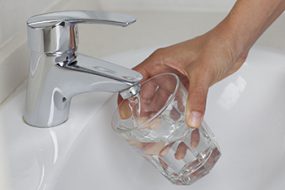Why Are Children, and Babies in Particular, Especially Effected by Lead in Water?
The most common sources of atomic number 82 in drinking h2o are lead pipes, faucets, and plumbing fixtures. Certain pipes that comport drinking water from the water source to the abode may incorporate lead. Household plumbing fixtures, welding solder, and pipage fittings made prior to 1986 may likewise contain lead.

Steps taken during the last two decades take reduced exposures to lead in tap h2o. These steps include actions taken under requirements of the 1986 and 1996 amendments to the Safe Drinking Water Actexternal icon and the U.S. Ecology Protection Agency's (EPA's) Lead and Copper Dominion.external icon Notwithstanding, lead in water tin can come from homes with lead service lines that connect the domicile to the principal water line. Homes without atomic number 82 service lines may still have brass or chrome-plated brass faucets, galvanized atomic number 26 pipes or other plumbing soldered with lead. Some drinking h2o fountains with atomic number 82-lined tanks and other plumbing fixtures not intended for drinking water (e.m., lab faucets, hoses, spigots, mitt washing sinks) may also have pb in the water.
Lead tin enter drinking h2o when a chemical reaction occurs in plumbing materials that contain lead. This is known as corrosion – dissolving or wearing away of metal from the pipes and fixtures. This reaction is more than severe when water has high acidity or low mineral content. How much lead enters the water is related to:
- the acerbity or alkalinity of the h2o,
- the types and amounts of minerals in the water,
- the amount of lead that water comes into contact with,
- the water temperature,
- the amount of wearable in the pipes,
- how long the h2o stays in pipes, and
- the presence of protective scales or coatings in the pipes.
You cannot come across, sense of taste, or scent lead in drinking h2o. The best mode to know your run a risk of exposure to lead in drinking water is to identify the potential sources of lead in your service line and household plumbing.
Your local water say-so is always your first source for testing and identifying lead contamination in your tap water. Ask your water provider if you take a atomic number 82 service line providing h2o to your dwelling. If you take a lead service line, ask if there are any programs to assist with removal of the pb service line going to your abode. Empathise that any work, such as water primary or service line replacement, could increase exposure to lead while the work is ongoing and for up to half dozen months after the piece of work is completed.
Ask to take your water tested. Many public water systems will test drinking water for residents upon request. There are as well laboratories that are certified to test for lead in water. Understand that h2o sampling results can vary depending on the fourth dimension of solar day, flavour, method of sampling, flow of water and other factors.
Because no safe blood level has been identified for young children, all sources of pb exposure for children should exist controlled or eliminated. EPA has set the maximum contaminant level goal for lead in drinking water at zero because lead can exist harmful to human health even at low exposure levels. Atomic number 82 is a toxic metal that is persistent in the surroundings and tin accrue in the torso over fourth dimension. Chance volition vary depending on the private, the chemical conditions of the h2o, and the amount consumed. For instance, infants who potable formula prepared with lead-contaminated tap water may be at a college risk of exposure considering of the big volume of h2o they consume relative to their body size. Bathing and showering should be safe for yous and your children because human pare does non blot lead in water.
If you think that you or your child has been exposed to lead in h2o, contact your health care provider. Most children and adults who are exposed to lead have no symptoms. The all-time manner to tell if you or your kid has been exposed is with a claret atomic number 82 examination. Your health care provider can help you decide whether a blood lead test is needed and can too recommend appropriate follow-up actions if you or your child has been exposed. As levels of lead in the blood increment, adverse effects from atomic number 82 may also increment.
Source: https://www.cdc.gov/nceh/lead/prevention/sources/water.htm
0 Response to "Why Are Children, and Babies in Particular, Especially Effected by Lead in Water?"
Postar um comentário